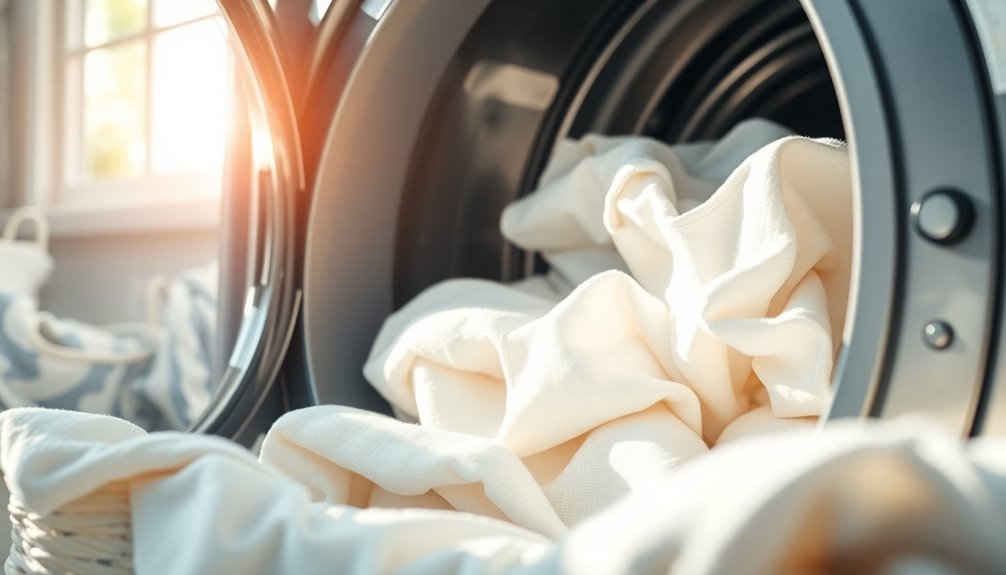Yes, you can put linen in the dryer, but it's essential to take some precautions. Always check the care label first, and if permitted, set your dryer to a low temperature below 90°F (30°C). Remove the linen while it's still slightly damp to avoid over-drying and potential shrinkage. Air-drying is the best option for fabric integrity. If you're curious about more tips on drying and caring for linen, there's plenty more to explore!
Key Takeaways
- Linen can be put in the dryer if the care instructions allow it, but always check the label first.
- Set the dryer to a low temperature below 90°F (30°C) to avoid damaging the fabric.
- Remove linen items while still slightly damp to prevent over-drying and maintain fabric integrity.
- Air-drying is preferred to reduce wrinkles and prolong the life of the linen.
- Ensure linen is completely dry before storage to prevent mold growth and maintain freshness.
What Makes Linen Fabric a Great Choice for the Home?
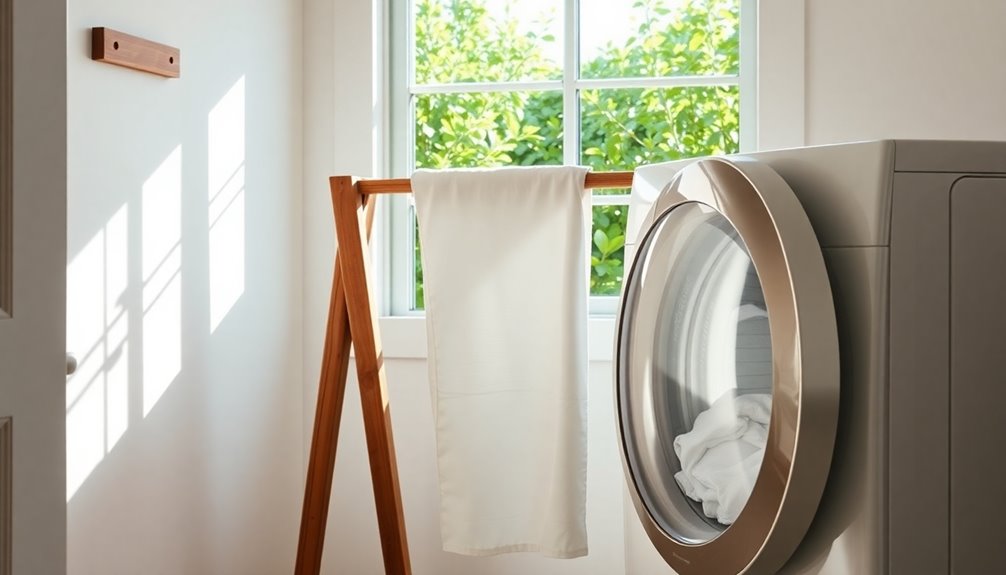
Linen fabric stands out as an exceptional choice for your home due to its unique blend of sustainability and comfort. Made from natural fibers derived from the flax plant, linen is a sustainable material that minimizes environmental impact during production.
You'll appreciate its breathability and temperature-regulating properties, keeping you comfortable in both warm and cool climates. Plus, linen has antibacterial qualities, making it an excellent option for maintaining cleanliness in your home textiles.
Its durability guarantees it withstands regular use, while the softness increases with each wash, enhancing its luxurious feel. With proper care for linen, you can enjoy its beauty and benefits for years to come, making it a truly practical addition to your decor.
How to Wash Linen Fabric
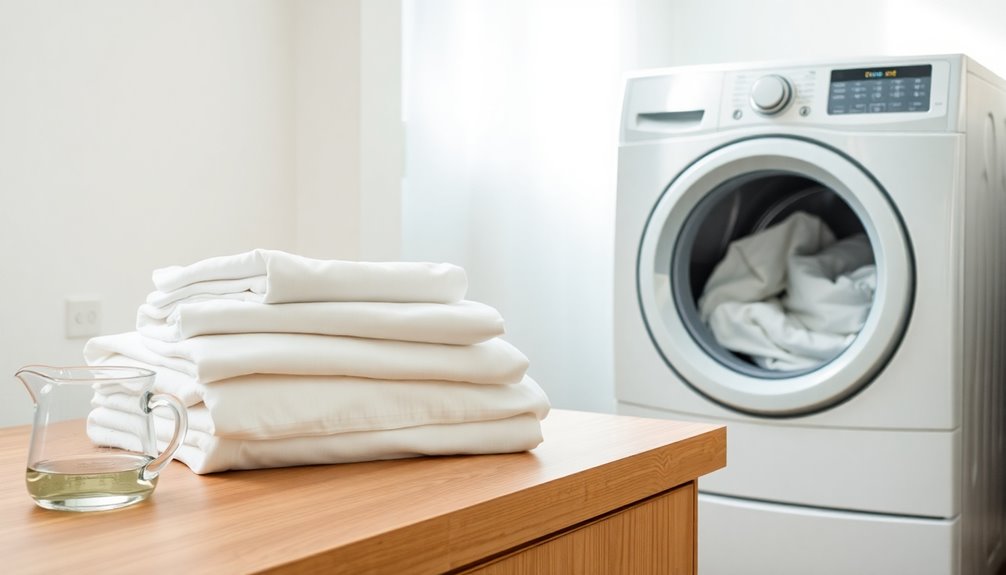
When washing linen fabric, always check the manufacturer's care label for specific instructions.
If you're dealing with vintage or unwashed linen, hand washing in warm water is usually the safest option.
Following these guidelines helps maintain the quality and longevity of your linen items.
Manufacturer's Washing Instructions
Before washing your linen items, it is crucial to check the manufacturer's washing instructions on the care label. Following these care instructions helps avoid damage and prolongs the life of your linen garments.
| Care Instruction | Recommendation |
|---|---|
| Wash Temperature | Warm water for most linen |
| Detergent | Use a mild detergent |
| Machine Overfilling | Avoid overcrowding the washer |
| Pre-washed Linen | Suitable for machine washing |
| Untreated Linen | Hand wash or gentle cycle |
Hand Washing Vintage Items
To guarantee your vintage linen items remain in pristine condition, hand washing is often the best approach.
Here's how to effectively clean linen:
- Fill a basin with warm water and a mild detergent, making sure it's completely dissolved before adding your fabric.
- Gently agitate the water to clean the linen, avoiding excessive friction that could damage delicate fibers.
- Rinse thoroughly with clean, lukewarm water to eliminate all detergent residue.
After rinsing, don't wring out the fabric. Instead, gently press the water out by rolling the linen in a clean towel.
Finally, always air dry linen away from direct sunlight to prevent fading and maintain its integrity.
Following these steps guarantees your vintage items remain beautiful and well-preserved.
Drying Linen Fabric: What You Need to Know

Understanding how to dry linen fabric properly is essential for preserving its quality and extending its lifespan. To achieve the best results, air drying is often recommended, as it prevents damage caused by high heat. Using a clothesline or a well-ventilated space can help maintain the fabric’s natural fibers and softness. Additionally, incorporating design techniques for textiles can further enhance the durability and appearance of linen, ensuring it remains a cherished part of your wardrobe for years to come.
When drying linen, you can use the dryer if the care instructions allow, but be sure to set it to a low temperature below 90°F (30°C) to avoid shrinking.
It's best to remove linen items while they're still slightly damp, which helps prevent over-drying and makes ironing easier.
Ideally, air-dry linen to maintain its integrity and reduce excessive wrinkling. Just remember to avoid direct sunlight, as it can fade and damage the fabric over time.
Always make certain linen is completely dry before storing it, since any remaining moisture can lead to mold and mildew growth.
Should You Iron Linen Garments?
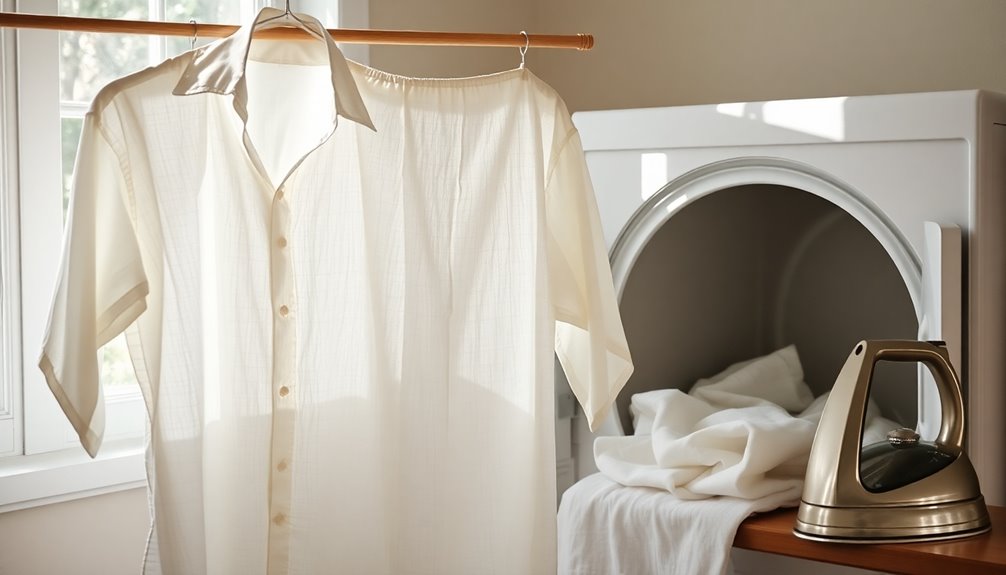
Ironing linen garments often comes down to your personal style.
If you love that relaxed look, you might embrace the natural creases.
However, if you prefer a crisp finish, here are some tips to take into account:
- Iron while slightly damp: This makes it easier to smooth out wrinkles effectively.
- Use medium-high heat: Avoid high heat as it can damage the fabric.
- Protect with a pressing cloth: This helps to shield your linen from direct heat.
How to Care for Linen Bedding, Linen Sheets, and Linen Clothes After Washing
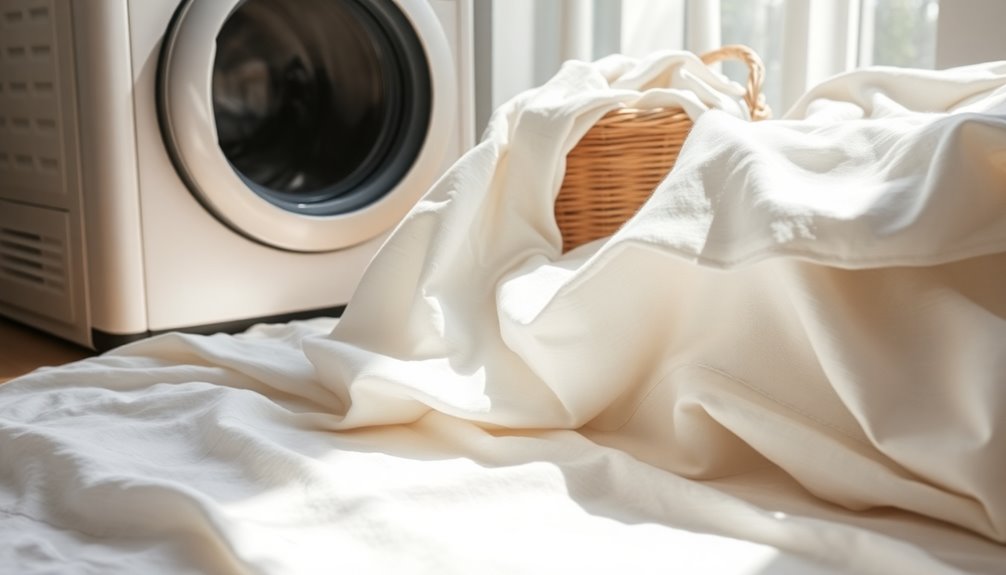
Once you've washed your linen bedding, sheets, or clothes, it's crucial to make sure they're completely dry before storing them. This prevents mold or mildew growth, which can damage the fabric. Store your items in a cool, dry place using breathable containers, avoiding plastic bags. Regularly air out your stored linen to keep it fresh, verifying everything is clean and dry first.
| Care Tips | Details |
|---|---|
| Drying | Confirm items are fully dry to prevent moisture damage. |
| Storage | Use breathable containers to avoid dust mites. |
| Ironing | Lightly iron while damp for a crisp look, if desired. |
For best longevity, steer clear of harsh detergents or bleach during washing.
Can You Put 100% Linen in the Dryer?
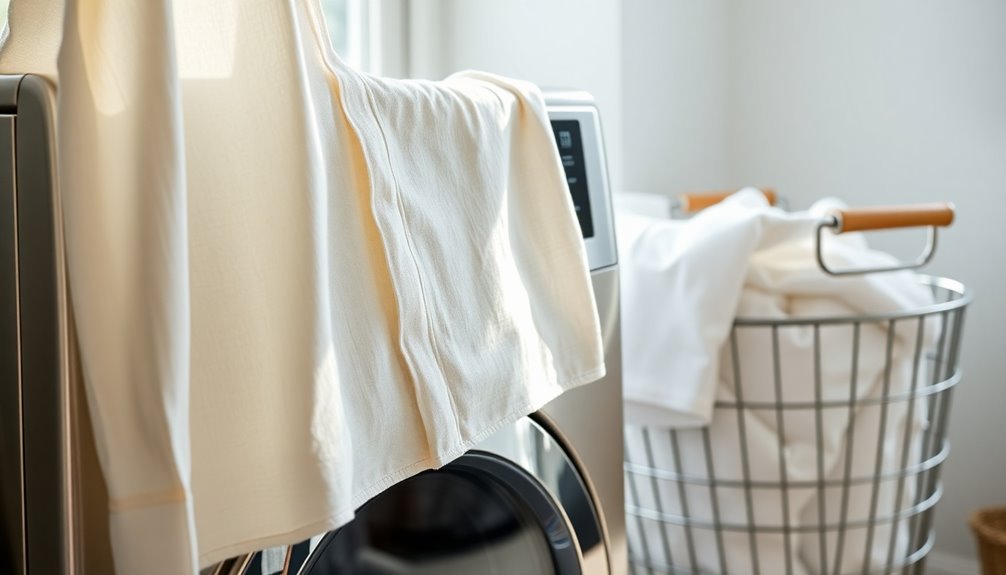
Can you safely toss 100% linen in the dryer? Yes, but you need to be cautious. Here are three key points to keep in mind:
- Use a low temperature: Set your dryer below 90°F (30°C) to avoid linen shrinking and maintain the fabric's integrity.
- Remove while damp: Take your linen out of the dryer when it's still slightly damp to prevent over-drying and excessive wrinkling.
- Check care labels: Always look for specific drying instructions on care labels, as many recommend against tumble drying.
If you decide to dry your linen in the dryer, consider air-drying afterward to further reduce wrinkles and make ironing easier.
How to Dry Linen Without Shrinking It
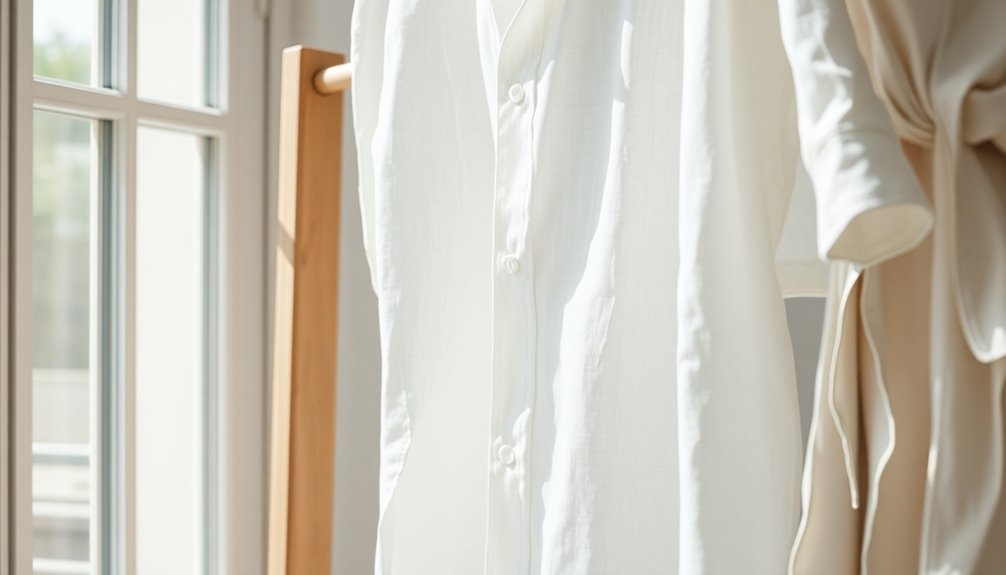
To keep your linen looking its best and prevent shrinkage, you'll want to use a combination of careful washing and drying techniques.
Start by washing your linen in cold water, as hot water can cause the fibers to contract.
When it comes to drying your linen, air-drying is the most effective method to avoid shrinkage, completely eliminating heat exposure risks.
If you do use a dryer, remember to avoid high heat; set it to a low temperature below 90°F (30°C).
Keep a close eye on drying your linen and remove items while they're still slightly damp.
Following care instructions on labels will also help you reduce the risk of shrinkage during washing and drying.
Best Methods for Drying Linen Clothes and Bedding
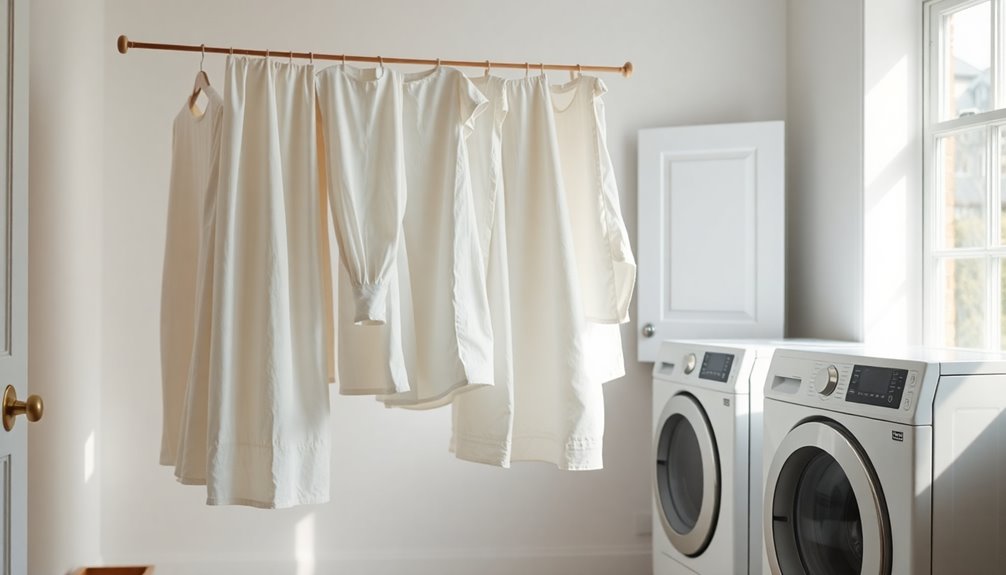
Air-drying remains the top choice for drying linen clothes and bedding, guaranteeing they maintain their shape and avoid shrinkage. Here are some effective methods to take into account:
- Hang linen sheets outdoors in fresh air, avoiding direct sunlight to prevent fading. Use padded hangers or lay them flat to preserve their shape.
- If you use a dryer, set it to low heat (below 90°F or 30°C) and remove items while still slightly damp to prevent over-drying.
- Confirm proper storage by monitoring drying time and ensuring items are completely dry to avoid mold or mildew.
Frequently Asked Questions
Is It Okay to Put Linen in the Dryer?
It's okay to put linen in the dryer, but you need to be cautious.
Always set the dryer to the lowest temperature to minimize shrinkage and damage. To avoid over-drying, take your linen out while it's still slightly damp.
However, check the care label first, since many recommend against tumble drying.
If you want to maintain the fabric's integrity, air-drying is usually the best option for keeping your linen looking great.
Does Heat Ruin Linen?
Yes, heat can ruin linen. When you expose linen to high temperatures, it can shrink considerably, losing its original shape and size.
Over-drying can make the fabric brittle and increase wrinkling, which affects its softness and comfort.
To preserve your linen, it's best to use low heat settings and remove it while slightly damp. This way, you'll maintain the fabric's natural integrity and guarantee it stays comfortable for years to come.
What to Do if You Accidentally Put Linen in the Dryer?
You've just tossed your precious linen in the dryer, haven't you?
First, grab it out right away to stop further heat damage. Check if it's still damp; if so, air-dry it.
While it's slightly damp, gently stretch and reshape it to counteract shrinkage.
Once it's not dripping, iron it with a medium-hot iron to smooth out wrinkles.
For the future, remember to always check those care labels!
What Happens if You Tumble Dry Linen Sheets?
If you tumble dry linen sheets, you might experience some shrinkage, typically between 3-10%.
Excessive heat can worsen this issue, so it's important to set your dryer to the lowest temperature.
When you take them out while they're still slightly damp, it helps reduce wrinkles.
However, over-drying can make the fabric brittle and prone to wear.
For best results, consider air-drying to maintain the quality and longevity of your linen.
Conclusion
To sum up, caring for your linen is as essential as tending to a delicate garden. While you can put 100% linen in the dryer, it's best to use low heat to avoid shrinking and damaging the fibers. Remember, air-drying is often gentler and helps maintain that beautiful texture. By following these tips, your linen will remain soft, durable, and looking fresh for years to come, enhancing your home just like a well-tended bloom.
